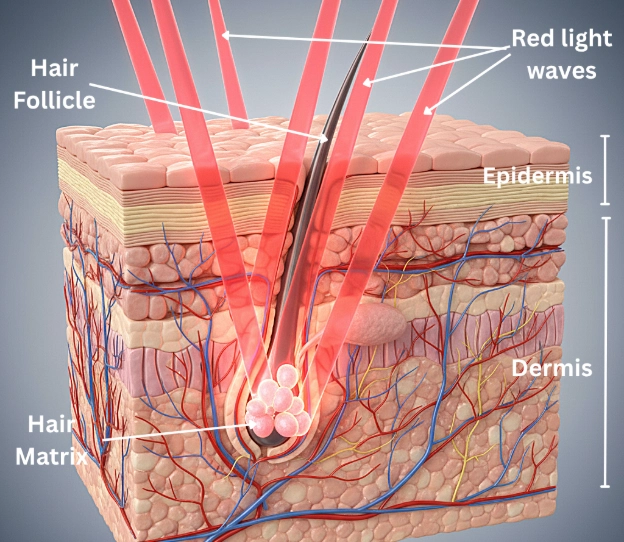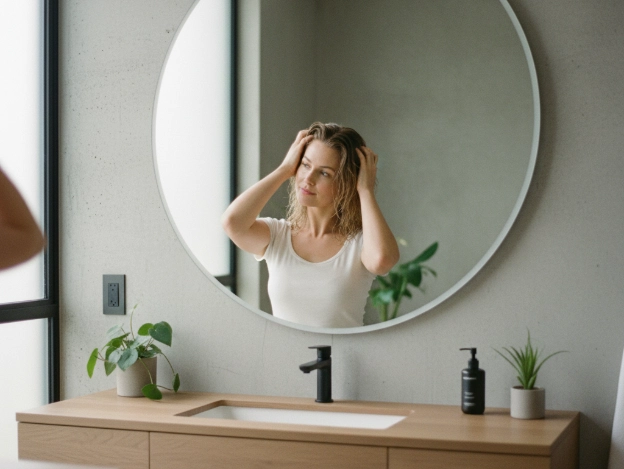Red Light Therapy Benefits for Hair? Here's what to expect

Losing hair hits harder than most people expect.
It’s not just vanity we’re usually dealing with here, it’s identity. You notice the thinning spot in photos, the handful of hair in the shower, the way your scalp feels more exposed to sunlight. And it’s frustrating, because you’re doing everything “right.” Taking care of your diet, managing stress (most days), maybe even trying shampoos or supplements that all promise the same miracle.
That’s usually where red light therapy sneaks into the conversation. You see someone wearing a futuristic helmet online or sitting under a glowing panel claiming their hair grew back… and you wonder, could that actually work?
Let’s break it down: the science, the results, the frustrations, and where red light therapy genuinely fits into the journey of regaining healthier, fuller hair.
What Is Red Light Therapy for Hair Loss?
At its core, red light therapy (or LLLT - low-level laser therapy) is light at specific wavelengths that gently energizes your cells.
Instead of chemicals or injections, it uses safe, non-invasive beams — usually between 630–680 nanometers for red light and 810–850 nm for near-infrared — to stimulate your scalp and help follicles function better.
Think of it like giving your cells a little more “juice.” More energy. More oxygen. More potential to stay alive and productive.
This isn’t fringe science, either. The FDA cleared it for pattern hair loss in both men and women years ago. And when you look at the Role of Low-Level Light Therapy (LLLT) in Androgenetic Alopecia review, which analyzed fifteen major studies, it becomes clear: consistent exposure to red and near-infrared light can help extend the growth phase of your hair cycle and revitalize sluggish follicles.
Some people do their sessions at clinics. Others use helmets, caps, or panels at home. Either way, the idea is simple: wake the follicles up before they shut down for good.
How Red Light Therapy Actually Works for Hair Growth
Here’s the biology, minus the extra jargon.
When red light hits your scalp, it passes through the top layers of skin and gets absorbed by the mitochondria inside your cells.The same little “energy factories" that fuel everything from your heartbeat to your metabolism. That light tells those cells to produce more ATP… which is basically cellular energy.
With that boost, the follicle cells can now:
Grow thicker strands instead of wispy ones.
Stay in the active (anagen) phase longer instead of shedding too soon.
Improve circulation, pulling more oxygen and nutrients toward the scalp.
Reduce inflammation, which is often the reason behind chronic thinning and irritation.
In a recent clinical trial, the 675-nm Wavelength Laser Therapy in the treatment of androgenetic alopecia (2024) participants saw over 17% increases in hair count and density within just four months. Another Clinical Trial Comparing Three Wavelengths in Photobiomodulation Therapy for Hair Loss (2025), tested red, near-infrared, and even far-infrared light. All three improved density and scalp health.
It’s fascinating how simple light can influence something that feels so complex. And if you’re already familiar with red light’s effects on energy and hormones, you might recognize some overlap here. Similar to what’s discussed in Red Light Therapy for Testosterone, where mitochondria activation plays a bigger systemic role.
Proven Benefits of Red Light Therapy for Hair Health
After months of reading, and cross- checking anecdotes, facts and published data, the benefits that kept surfacing weren’t flashy. They were steady, measurable, and real:
1. Fuller-looking hair, not just in your mind.
Studies consistently show density increases of 30-40% when used regularly. You start to notice the scalp showing less in bright light, or that ponytail feeling thicker again.
2. Less shedding in the early weeks.
For a lot of people, that’s the first sign something is changing. Less hair in the brush, fewer strands on the pillow.
3. Better scalp comfort.
It’s common knowledge that a calmer, less irritated scalp tends to grow better hair. Red light therapy reduces inflammation and balances oil production, making the environment more supportive for follicles.
4. Stronger, thicker strands.
The Role of Low-Level Light Therapy (LLLT) in Androgenetic Alopecia review showed significant increases in hair shaft diameter. On paper.. Its a small change,but it is still one that thickens the hair.
5. Consistency pays off.
Every positive study… from the 675-nm Wavelength Laser Therapy Study (2024) to the Clinical Trial Comparing Three Wavelengths in Photobiomodulation Therapy for Hair Loss , all had one thing in common: The participants who stuck to the plan!
That’s not very exciting, but it’s honest. You can’t outsmart biology; you have to work with it.
How to Use Red Light Therapy for Hair Growth (At Home or in Clinic)
Getting results isn’t about chasing the fanciest device. It’s about doing it right and doing it often.
Most people see progress using red light 3-5 times per week, 10-30 minutes per session.
More frequent use doesn’t mean faster growth; it just increases the chance you’ll burn out on the routine.
Start with clean, dry hair, and part your hair so light actually reaches your scalp (not just the top layer of hair). If you’re using a helmet or cap, make sure it fits snugly. With a panel, aim for 6-12 inches away and reposition occasionally so you hit every angle.
Different devices and setups have their quirks:
Helmets and caps are easiest. You put them on, let the timer run, and move on with your day.
Panels can be multitasked for other recovery routines, but you’ll need to position them well.
Combs or handhelds are fine if you have the patience.
A key rule: don’t just double your sessions in one day because you’re impatient. More light doesn’t equal faster results. You risk overloading your cells. We talk about why pacing matters in Can You Do Red Light Therapy Twice a Day … especially if you’re using a high-power device.
Some people prefer professional sessions. Clinics often use similar wavelengths but at higher intensity. The tradeoff? Price. A few months of treatments can easily cost as much as buying your own device. Either path works if you commit.
Red Light Therapy Dangers (What to Watch Out For)
Here’s the good news: red light therapy is considered very safe. But there are a few things to keep in mind:
1. Early shedding isn’t failure.
When follicles re-enter the growth cycle, some older hairs can shed all at once. It can be alarming, but it’s actually a positive reset that usually settles within 4-8 weeks.
2. Mild scalp sensitivity can happen.
You might feel warmth, tingling… or a little redness after a session, that is totally normal. If it lingers, reduce your session time or space them out for a week or two.
3. Protect your eyes.
Never look directly at LEDs or lasers. Always wear goggles or keep your eyes closed and angled away from the light.
4. Don’t overdo it.
Daily exposure can be fine at low doses, but doubling up or sitting too close just strains your skin. Give your cells time to respond between sessions.
5. Some people should skip it.
If you’re on photosensitizing medication, have an active scalp infection, or are pregnant, or have any known health condition..wait or talk to your doctor first.
If safety is your top concern (and it should be), there’s a great breakdown on managing exposure and heat in Infrared Sauna Dangers (And How to Avoid Them) … it applies surprisingly well to red light too.
Is It Worth It? A Realistic Take
Here’s the truth most marketing pages skip: red light therapy doesn’t work for everyone.
But it works for enough people. Around 35-45% of users in controlled trials. It deserves to be part of the conversation.
If your hair is thinning but not gone, if you can commit to using it consistently for a few months, and if you want something safe and non-invasive, it’s absolutely worth exploring.
What makes it so interesting isn’t just the regrowth, it’s the momentum it brings. That feeling of doing something proactive and seeing gradual improvement instead of decline. It can genuinely change how you feel about yourself.
And if you’re curious about how other recovery tools stack up beside it, there’s a detailed comparison here: PEMF vs Red Light Therapy. It helps put red light into perspective within the broader recovery toolkit.
Conclusion
There’s a quiet kind of hope that comes with any hair recovery story. Red light therapy isn’t a miracle cure … it’s more like gentle, consistent encouragement for your scalp. The science is solid, the risk is low, and the process rewards patience over perfection.
If you give it time and stick with it, that mirror moment … the one where you catch yourself noticing more hair instead of less …feels incredible. And honestly, that’s worth the commitment.
Frequently Asked Questions
1. How long before I notice changes?
Usually within 6-12 weeks, you’ll notice less shedding and a calmer scalp. Fuller density and new growth tend to show up after 3-6 months.
2. Will it regrow hair on completely bald spots?
Probably not. It works best on follicles that are still alive but underperforming - think thinning, not gone.
3. What’s the ideal wavelength for hair growth?
Most research centers on 630–680 nm red light, sometimes paired with 810–850 nm near-infrared. Both ranges stimulate mitochondrial energy and scalp circulation.
4. How often should I do it?
About 3–5 sessions per week, 10–30 minutes each, depending on the device’s strength.
5. Can it cause shedding?
Yes, briefly. A “reset shed” as new growth cycles begin. It typically stabilizes within a month or two.
6. Can I combine it with other treatments?
Yes. Pairing red light with scalp massage, proper nutrition, or topical treatments often boosts results - something also seen in the Role of Low-Level Light Therapy (LLLT) in Androgenetic Alopecia review.
7. Is it safe long-term?
When used correctly, yes. Red light therapy has an excellent safety record, with side effects limited to mild scalp warmth or redness in rare cases.
Keep Exploring
Slip inside and let steady heat do the work.A simple way to unwind, sweat, and feel that slow melt of tension fades out of your body.
The truth about those buzzing recovery tools… when they actually ease muscle tightness and when they’re just adding noise to your routine.
From post-workout rituals to lazy Sunday recovery, we break down whether compression boots deliver real relief or just feel good in the moment.
This article is for informational purposes only and is not intended to provide medical advice. Always consult your qualified healthcare professional before beginning any new health, wellness or recovery regimen.





